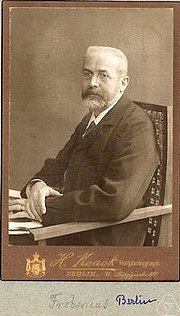Frobenius covariant: Difference between revisions
| Line 26: | Line 26: | ||
Consider the two-by-two matrix: |
Consider the two-by-two matrix: |
||
:<math> A = \begin{bmatrix} 1 & 3 \\ 4 & 2 \end{bmatrix}.</math> |
:<math> A = \begin{bmatrix} 1 & 3 \\ 4 & 2 \end{bmatrix}.</math> |
||
This matrix has two eigenvalues, 5 and −2; hence {{math| (''A'' |
This matrix has two eigenvalues, 5 and −2; hence {{math| (''A'' − 5)(''A'' + 2) {{=}} 0}}. |
||
The corresponding eigen decomposition is |
The corresponding eigen decomposition is |
||
Revision as of 23:43, 17 December 2020
In matrix theory, the Frobenius covariants of a square matrix A are special polynomials of it, namely projection matrices Ai associated with the eigenvalues and eigenvectors of A.[1]: pp.403, 437–8 They are named after the mathematician Ferdinand Frobenius.
Each covariant is a projection on the eigenspace associated with the eigenvalue λi. Frobenius covariants are the coefficients of Sylvester's formula, which expresses a function of a matrix f(A) as a matrix polynomial, namely a linear combination of that function's values on the eigenvalues of A.
Formal definition
Let A be a diagonalizable matrix with eigenvalues λ1, …, λk.
The Frobenius covariant Ai, for i = 1,…, k, is the matrix
It is essentially the Lagrange polynomial with matrix argument. If the eigenvalue λi is simple, then as an idempotent projection matrix to a one-dimensional subspace, Ai has a unit trace.
Computing the covariants

The Frobenius covariants of a matrix A can be obtained from any eigendecomposition A = SDS−1, where S is non-singular and D is diagonal with Di,i = λi. If A has no multiple eigenvalues, then let ci be the ith right eigenvector of A, that is, the ith column of S; and let ri be the ith left eigenvector of A, namely the ith row of S−1. Then Ai = ci ri.
If A has an eigenvalue λi appear multiple times, then Ai = Σj cj rj, where the sum is over all rows and columns associated with the eigenvalue λi.[1]: p.521
Example
Consider the two-by-two matrix:
This matrix has two eigenvalues, 5 and −2; hence (A − 5)(A + 2) = 0.
The corresponding eigen decomposition is
Hence the Frobenius covariants, manifestly projections, are
with
Note trA1 = trA2 = 1, as required.
References
- ^ a b Roger A. Horn and Charles R. Johnson (1991), Topics in Matrix Analysis. Cambridge University Press, ISBN 978-0-521-46713-1





